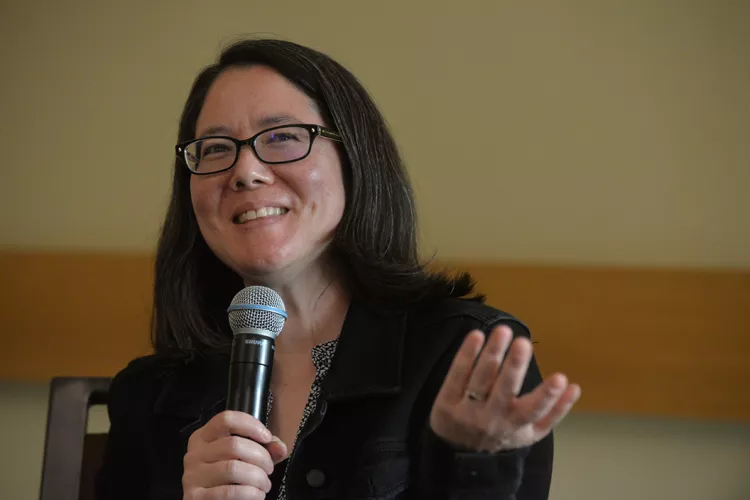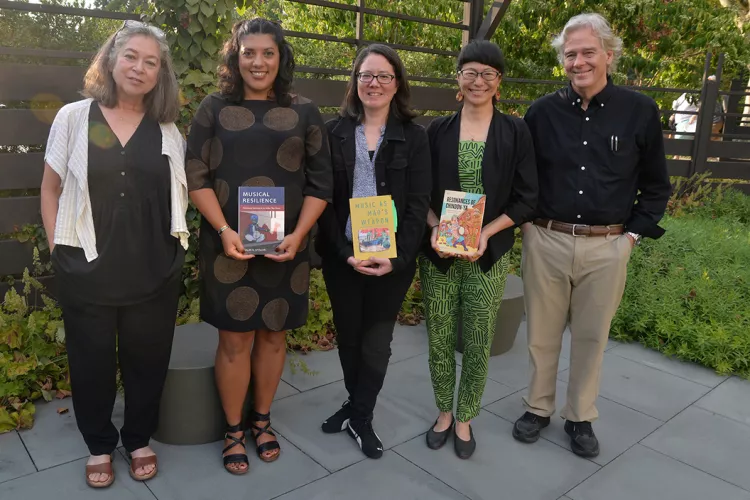Ethnomusicology At Swarthmore and Beyond: Space, Time, and History Through Sound

A new book from Associate Professor and Chair of Music Lei Ouyang, Music as Mao’s Weapon: Remembering the Cultural Revolution, was the inspiration for a conversation centered on ethnomusicology.
Swarthmore faculty, students, and residents, joined by music scholars and alumni from the greater Philadelphia area, gathered this month for a book launch and conversation organized by the Aydelotte Foundation. The subject, ethnomusicology and its importance, brought together ethnomusicologists from universities across the U.S. and from Swarthmore.
A new book from Associate Professor and Chair of Music Lei Ouyang, Music as Mao’s Weapon: Remembering the Cultural Revolution (University of Illinois Press 2022), was the inspiration behind this event. Ouyang was joined on a panel by Marié Abe ’01, associate professor of music at UC-Berkeley and Shalini Ayyagari ’00, associate professor of music at the University of Pittsburgh. Swarthmore’s Mari S. Michener Professor of Religion Steven Hopkins and Professor of Music Deborah Wong from UC Riverside, one of the foremost ethnomusicologists today, served as discussants to offer questions, observations, and commentary.
Ethnomusicology is the study of music in social and cultural contexts; it was the underlying theme of the panel and the works presented. “For me, sound is at once material and ephemeral, it's at once acoustic and physical and physiological. Listening is a socialized and cultural practice,” Abe said, explaining why music, and ethnomusicology specifically, are where her passions lie. The ever-changing nature of music requires ethnographic attention, Abe believes, as it leads us to pay attention to the texture of the everyday and the sounds around us.
Abe’s book, Resonances of Chindon-ya: Sounding Space and Sociality in Contemporary Japan (Wesleyan University 2018), examines the intersection of sound, space, and sociality through an ethnographic analysis of a Japanese street musical practice called ‘Chindon-ya.’ She described it as “a simultaneously acoustic and affective work of sounding that articulates latent sociality, the acoustic environment and sedimented histories.”
For Ouyang, her monograph and ethnomusicology teaching stems from “trying to understand lived experiences.” Examining the music and songs from the Cultural Revolution in China (1966-76), Ouyang’s book examines the impact of political propaganda through music, alongside notions of memory and totalitarianism.
“I talk a lot about how we can’t just think of one slice of life during that time but how everything is interconnected,” Ouyang says. “As an ethnomusicologist, my lens is to look at the music, yes, but never just the sound itself. Always in connection with the people, the politics, the history and the context of the time.”
These are key ideas grounding the ethnomusicological study of music — Ayyagari’s book is a strong example of the role history and tradition play in the manifestation and presentation of music. Musical Resilience: Performing Patronage in the Indian Thar Desert (Wesleyan University 2022) focuses on the Manganiyar, groups of hereditary musicians whose music is supported and financed by wealthy patrons. They preserve oral traditions through their music, performing at life cycle ceremonies, births and weddings.

From left: Deborah Wong, Shalini Ayyagari ’00, Lei Ouyang, Marié Abe ’01, and Steven Hopkins
Historically, this community is considered to be very low caste despite performing for aristocratic families for generations. “Part of what I do in this book is tell the story of post-independence India through the lens of the nonlinear community. The Manganiyar community has a beautiful history of music that has stood the test of time and they are increasingly transitioning to more commercial avenues with the help of sponsors and patrons to make a livelihood,” Ayyagari said, going on to talk about the idea of ‘resilience’ in her text. Ayyagari found resilience to be a vital theme — not only resilience in music and how it can transition between traditional and contemporary, but also the resilience of these communities in keeping their sound alive.
Wong and Hopkins offered their final remarks on ethnomusicology and the books in front of them. For Hopkins, music is more than just notes on a paper.
“I think of music as encompassing space and time, historical narratives and the nostalgia for things we might never have experienced,” he said.
For Wong, reading these texts grounded in ethnomusicology represent remarkable progress and recognition of the field.
“Your books represent a lot of core values and assumptions and commitments that are signs of where ethnomusicology is in North America,” says Wong. “For a long time, our discipline was committed to cultural coherence, but the three of you show that culture is always changing. You move past the romantic ideals of sound to look instead at dynamics and social properties that reach across time, space, and different social modalities. Ethnography is looking at the pain points in music studies and we have to be listening to the most fraught and contentious research and conversations by the most capable scholars.”



